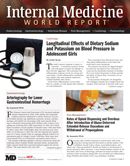Publication
Article
Internal Medicine World Report
Does CTA before Arteriography for Lower GI Hemorrhage Improve Outcomes?
Author(s):
Preceding visceral arteriography (VA) with a diagnostic study using computed tomographic angiography (CTA) improved positive localization of the site of lower gastrointestinal (GI) hemorrhage compared with VA alone, according to a new study published in May in JAMA Surgery.

Preceding visceral arteriography (VA) with a diagnostic study using computed tomographic angiography (CTA) improved positive localization of the site of lower gastrointestinal (GI) hemorrhage compared with VA alone, according to a new study published in May in JAMA Surgery.
Researchers at the University of Pennsylvania Perelman School of Medicine, led by Christina L. Jacovides, MD, analyzed prospectively acquired data from an interventional radiology database and individual electronic records from an academic tertiary medical center where, beginning in January 2009, a new evidence-based institutional protocol was launched that incorporated CTA to manage acute lower BI hemorrhage.
All records of patients who underwent VA for acute lower GI hemorrhage from January 1, 2005, through December 31, 2012, were evaluated. VA results and efficacy were compared in patients before and after protocol implementation and compared based on which imaging method was used prior to angiography.
A total of 161 angiographic procedures were performed during the study period, 78 before, and 83 after protocol implementation. Use of CTA increased from 3.8% to 56.6% and use of nuclear scintigraphy decreased from 83.3% to 50.6% following protocol implementation (P < .001).
Preceding angiography with CTA resulted in similar angiography contrast administration and fluoroscopy time. Although nuclear scintigraphy and CTA has similar sensitivity and specificity, localization of the site of hemorrhage by CTA was more precise and consistent with angiography findings. Furthermore, compared with nuclear scintigraphy, CTA as a pre-angiography test reduced overall the number of imaging studies needed, and resulted in the administration of more overall contrast without worsening renal function.
The investigators concluded that CTA could be used as part of a lower intestinal hemorrhage management algorithm and did not appear to worsen renal function despite the additional contrast load.





